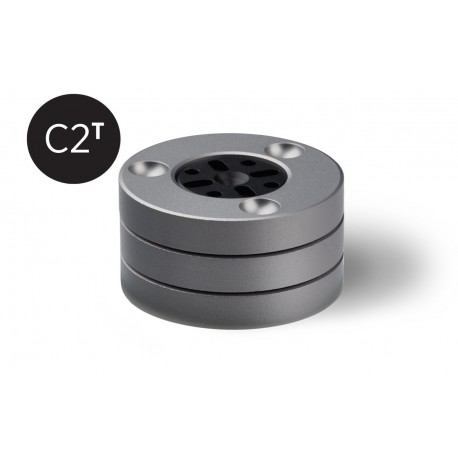No products
Prices are tax included

ANSUZ DARKZ C2T
HIANS001
ANSUZ DARKZ C2T
The Darkz C2T resonance control is created with three aluminium discs that have been treated with an extra hard anodization to optimize the material to lead away unwanted vibrations.
The two upper discs float on three titanium balls to give the Darkz its resonance handling properties.
price for one piece - need 3 or 4 untis for a device
In both the design and production phase, scientists at the Technology Institute of Jutland have played a critical role. Without their extensive knowledge about materials and their refined skills in operating the advanced particle accelerators, we could have never achieved this final outcome.
The bare Titanium discs are mounted on racks and sandblasted to have the proper surface finish as the appearance of the final product is highly contingent upon the surface topography prior to the coating deposition.
After sandblasting, the Titanium discs are cleaned in an ultrasonic bath and further cleaned in a water cascade with demineralized water to make sure they are completely free of any dirt and grease. The discs are then dried and stored in an oven until they are ready to be coated.
Prior to the coating process, the Titanium discs are mounted on holders that can be inserted into the particle accelerator. In the deposition chamber, large pumps extract all air that is in the chamber to create conditions similar to those in outer space. To guarantee perfect conditions of the vacuum, the coating unit with the discs is heated to remove water and other contaminants that are in the air.
Even these pure conditions do not suffice to achieve the desired quality level! A small amount of Argon gas is let into the chamber to receive a perfect adhesion of the coating to the Titanium discs. By applying a voltage to these discs, they are exposed to a bombardment of Argon ions. This removes the naturally formed oxides from the Titanium surface. Under these conditions, high-performing coatings can be applied and spread on the surface of the Titanium discs.
The acoustically optimized layers of Zirconium and Tungsten are then deposited on the Titanium surface, and finally a hard layer of Aluminum Titanium Nitride is added to obtain the desired surface properties and the intended visual appearance.
After everything is cooled down, the coating unit is vented, and the coated Titanium discs can now be taken off the holders. Quality control checks if the adhesion and thickness of the coating are within the set specifications. The adhesion test is performed by pushing a diamond tip through the coating and deep into the substrate.
The second part of the quality inspection consists of the measurement of the thickness of the coating. For this, a ball is being ground through the coating layers supported by the application of a diamond paste. Under a microscope, the individual layers become visible and can be measured precisely. After the Ansuz Darkz have passed the quality control, they have to undergo a final visual inspection before they are packed and ready for assembly.
